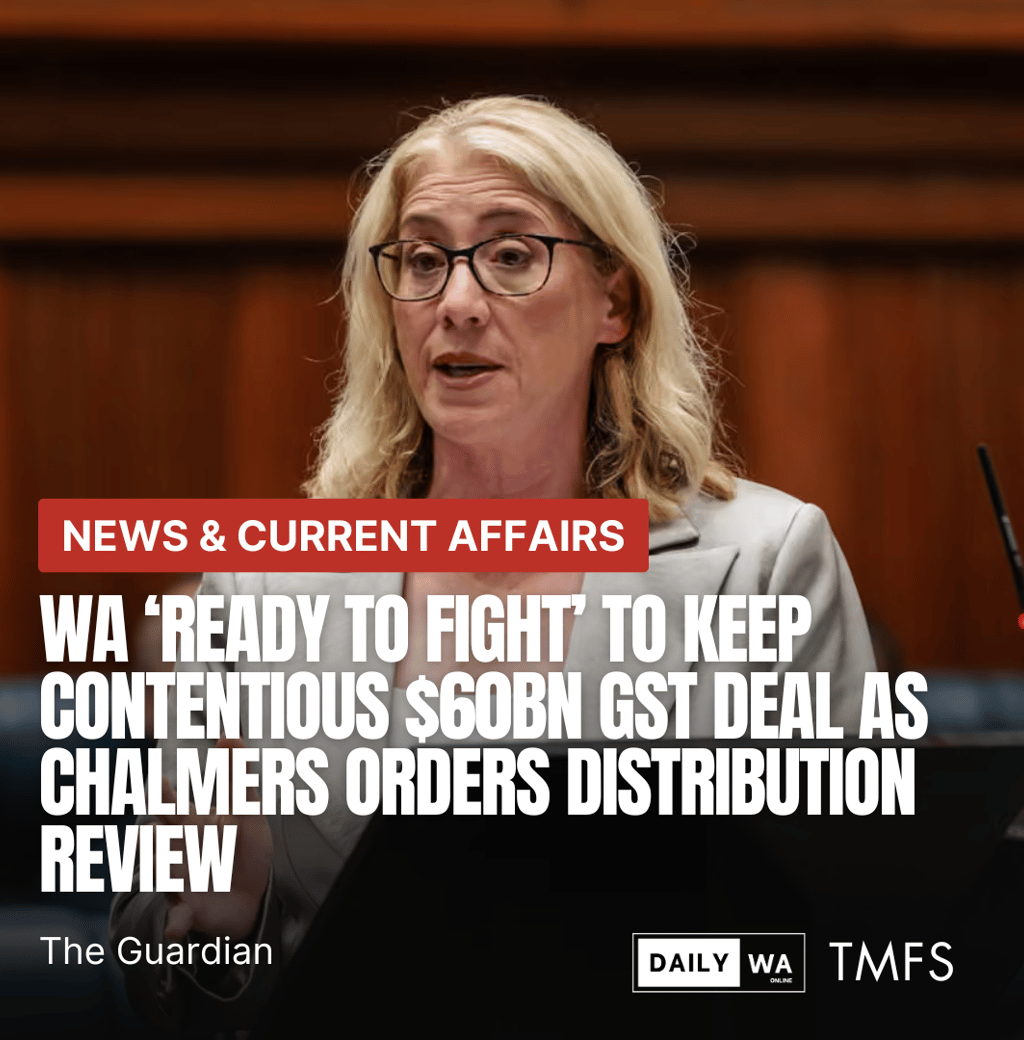WA Gears Up for a Fiscal Showdown: The $60 Billion GST Deal That Could Redefine Federal Fairness
As Treasurer Jim Chalmers launches a national review into GST distribution, Western Australia vows to defend its $60 billion carve-out — reigniting a debate over equity, economic strength and the meaning of a fair federation.
NEWS & CURRENT AFFAIRS


Western Australia has signalled its stance in no uncertain terms: it is ready to fight. With Federal Treasurer Jim Chalmers ordering a formal review of GST distribution, a once-settled deal worth $60 billion is back under scrutiny — and with it, the fragile balance of Australia’s federal financial compact.
The stakes could not be higher. For more than a decade, WA has argued that its resource-driven prosperity should not come at the expense of a fair return on its own revenue. When the Commonwealth agreed in 2018 to floor WA’s share at 70 cents per dollar — later rising to 75 cents — it ended years of discontent but sowed new tensions across state lines. Now, as fiscal pressures tighten and national deficits deepen, that compromise is being tested.
At the heart of the debate is a moral question dressed in economic data: What does fairness look like in a federation where success breeds redistribution?
The politics of parity
Australia’s Goods and Services Tax (GST) is pooled nationally and redistributed according to each state’s fiscal capacity. In theory, this equalisation ensures that Australians, regardless of postcode, have access to comparable services. But in practice, booming states like Western Australia often contribute disproportionately more.
By 2015, WA’s share had plunged as low as 30 cents per dollar, fuelling a political crisis that cut across parties and reshaped the state’s relationship with Canberra. The eventual reform — a “floor” guaranteeing a minimum return — stabilised WA’s revenues and allowed the state to reinvest in infrastructure, jobs and public services.
Critics in other jurisdictions, however, see it differently. They argue that the WA floor distorts horizontal equity by protecting one state from cyclical downturns while leaving others exposed. With the national economy facing simultaneous headwinds — slowing growth, rising debt, and cost-of-living pressures — voices from New South Wales, Victoria and South Australia are growing louder, demanding a re-examination of the formula.
Chalmers’ review, expected to report before the next federal budget, could reset expectations on what each state deserves versus what the federation can sustain.
WA’s line in the sand
For Western Australia, this is not just an accounting exercise; it is a matter of sovereignty, identity and economic justice. Premier Roger Cook has been unequivocal, describing the deal as “non-negotiable” and warning that any rollback would punish the only state consistently contributing budget surpluses.
WA’s argument rests on two pillars: contribution and consistency. The state supplies nearly half of Australia’s resource export earnings, underwrites federal royalties through mining taxes, and weathered the pandemic with economic resilience that buoyed national GDP. From Perth’s perspective, the GST floor is not a handout — it is a fair dividend for reliability.
Economists, however, point to emerging risks. As commodity cycles shift and federal budgets tighten, maintaining WA’s guaranteed floor may require additional top-ups from Commonwealth coffers — effectively shielding the state from volatility others must bear. Critics argue that such asymmetry erodes national cohesion and undermines the purpose of equalisation.
The economics behind the emotion
At its core, this debate is not about envy but equilibrium. Fiscal equalisation is a delicate art: overcompensate and you breed resentment; underfund and you entrench disparity. The GST floor was designed as a stabiliser — yet stabilisers, by design, are temporary.
Treasury officials now face a complex modelling task: balancing fiscal sustainability with political viability. Any adjustment risks alienating either side — WA voters who view the floor as overdue justice, or eastern states that see it as preferential treatment.
This tension reveals the deeper truth of federal economics: every dollar is a story of trade-offs. When one jurisdiction receives more certainty, another absorbs more risk. The review will test not just arithmetic but Australia’s capacity for collective reasoning — whether it can reconcile success with solidarity.
A nation at a crossroads
WA’s readiness to defend its position speaks to a broader sentiment emerging across the country: the desire for recognition, respect and agency within a shared system. The GST fight is not an isolated skirmish; it is emblematic of a federation grappling with uneven prosperity and evolving expectations.
What happens next will influence far more than balance sheets. It will shape how Australians perceive fairness, how governments frame contribution, and how future reforms navigate between independence and interdependence.
For now, Western Australia stands firm — fortified by surpluses, emboldened by principle, and determined to protect what it sees as a hard-won victory. The rest of the nation watches, aware that the outcome will ripple through every future negotiation where equity meets ambition.
At TMFS, we recognise moments like these as more than fiscal footnotes. They are tests of collective psychology — how narratives of fairness and reward prime our understanding of policy and purpose. True leadership lies not in claiming more, but in creating frameworks where prosperity uplifts all.
The GST debate is not over a number. It is over a nation’s definition of fairness. And that makes it worth every conversation it provokes.
All rights belong to their respective owners. This article contains references and insights based on publicly available information and sources. We do not claim ownership over any third-party content mentioned.
